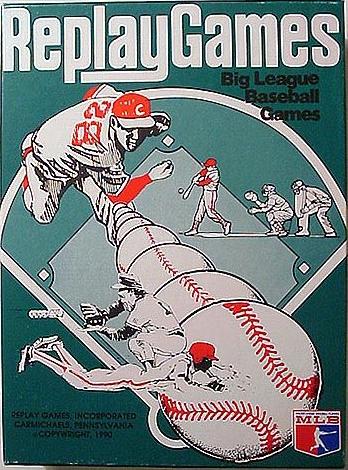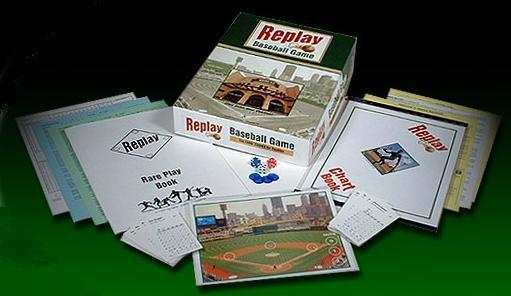REPLAY BASEBALL GAME
by Al Arthurs
GAME HISTORY
Replay Games began back in 1973 when Norm Roth of Hamilton, Ontario (a longtime APBA player and Canadian representative for the game) teamed up with John Brodak (another APBA player) of Carmichaels, Pennsylvania to expand upon the idea of a better baseball game. They felt that the games on the market lacked several key components, and Norm began to flesh out ideas for the game. After a couple of failed attempts, Norm came up with the idea of adding both the batter's and pitcher's numbers together to get the play results.
The game company was formed, and John utilized his print shop in Carmichaels to produce the first card set, which was the 1972 season. They printed only 1000 copies, and sold few of them. The next couple of seasons saw their customer base increase as word of mouth of the game spread throughout the gaming community. Each new season produced brought some changes to the game as Norm began to fine tune the game engine, with new numbers and plays brought in, including a rare play chart, platooning splits for the batters, and expanded fielding ratings.
A couple of years after the game was on the market, Norm created his first old-time set, which was the 1927 season. Soon others began to follow, including 1961, 1876, 1934 and 1968. With the popularity of these old time seasons, Gary Plunkitt was added to the Replay staff to make the future old-time sets, and he began a run of seasons from 1946 to 1955 among other seasons. Replay also expanded into football, creating their first set in 1978. The football game, however, was discontinued after a couple of seasons.

Soon a thriving Replay community began to grow as leagues were formed, fan newsletters were born (including Instant Replay edited by Jim Pertierra), and conventions were organized throughout the late 1970s and the early 1980s, often drawing fanatics that numbered in the dozens who came from all parts of the continent. By the early 1980s, the game was one of the top rated in the market with a large fan base and glowing reviews from gamers everywhere, and the game company had plans to market a golf game, and a computer version of their baseball game. However, continuing financial demands from the Major League Players Association began to wear the company down, and they decided to fold the company in 1991 rather than pass the expanding fees onto their customers.
The game was dead at that point other than a league that printed their own cards, and it lay dormant until 1995 when Vince Crystal acquired the rights to the game and made a 1994 and 1894 season. That was all he came up with in his run at the game, and Replay lay dormant again until 1999 when Pete Ventura of Ohiopyle, Pennsylvania resurrected the game for another run.
Pete centered the game company on customer service, and soon fans began to flock back to the fold. He made every current season ever since, and added some touches of his own to the game engine, including expanded platooning for the batters, fine-tuned fielding ratings, a pitcher's card that uses a third die, and ballpark effect cards. He also produced card sets for the best teams of certain decades (including Deadball, and the 1970s and 1980s), a set of great minor league teams, and a 1923 Negro League set with help from Patrick Rock. The game company also puts out basketball sets (including decade sets) produced by Dave Loparco, and has acquired the rights to Second Season Football. The future is looking better for Replay Games at this point.

GAME DESIGN
The concept of Replay baseball is quite simple. There are three dice used. Two dice are used for the batter's card, which is divided into a 36-section grid, and a third die is used for the pitcher's card, which is also divided into a 36-section grid. This allows a unique interaction between the batter and pitcher, and fielding comes into play as certain plays have the fielder's ratings added to the play result. Fielders have ratings for range, arm, and error percentages. Batters are also rated for platooning, speed, bunt ratings, and hit and run prowess. Pitchers have numerous ratings on their cards, including such things as ratios for hits, strikeouts, walks and homeruns, batter durations for starts and reliefs, holding batters on base, and wild pitches.
A unique feature of this game is also that you can custom fit it to your style with optional rules, the two most prolific being an optional stolen base system and ballpark factor cards, which rate all of the major league ballparks for such things as frequency of homeruns and foul territory.
The game has evolved over the years with numerous changes. While it may be difficult to have compatibility with the older sets as compared with the newer sets, the changes that have occurred over the years only improve the game to a better level. It is one of the best games on the market, and has received nothing but praise from people who have played the game, even for only one time.
REPLAY BASEBALL LINKS
